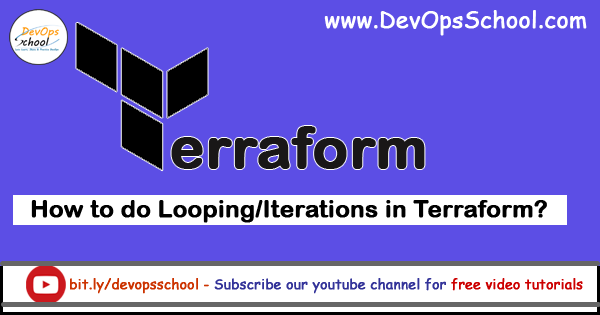
Resources
Resources are the most important element in the Terraform language. Each resource block describes one or more infrastructure objects, such as virtual networks, compute instances, or higher-level components such as DNS records supported by providers.
Resources type
Each resource is associated with a single resource type, which determines the kind of infrastructure object it manages and what arguments and other attributes the resource supports.
Provider
Each resource type in turn belongs to a provider, which is a plugin for Terraform that offers a collection of resource types. A provider usually provides resources to manage a single cloud or on-premises infrastructure platform.
Resource Behavior by Meta-Arguments
Resource Behavior by Meta-Arguments, which can be used with any resource type to change the behavior of resources:
- depends_on, for specifying hidden dependencies
- count, for creating multiple resource instances according to a count
- for_each, to create multiple instances according to a map, or set of strings
- provider, for selecting a non-default provider configuration
lifecycle, for lifecycle customizations - provisioner and connection, for taking extra actions after resource creation
count: which allows Multiple Resource Instances By Count
Out of these, count: which allows Multiple Resource Instances By Count and this Meta-Arguments can be used to Multiply resources which can be used as an alternative to Looping and Interators in Terraform.
resource "aws_instance" "example" {
ami = "ami-2d39803a"
instance_type = "t2.micro"
}
###### WRONG WAY ######
for i = 0; i < 3; i++ {
resource "aws_instance" "example" {
ami = "ami-2d39803a"
instance_type = "t2.micro"
}
}
###### RIGHT WAY ######
resource "aws_instance" "example" {
count = 3
ami = "ami-2d39803a"
instance_type = "t2.micro"
}Code language: PHP (php)for_each: Multiple Resource Instances Defined By a Map, or Set of Strings.
If your resource instances are almost identical, count is appropriate. If some of their arguments need distinct values that can’t be directly derived from an integer, it’s safer to use for_each.
Before for_each was available, it was common to derive count from the length of a list and use count.index to look up the original list value:
variable "subnet_ids" {
type = list(string)
}
resource "aws_instance" "server" {
# Create one instance for each subnet
count = length(var.subnet_ids)
ami = "ami-a1b2c3d4"
instance_type = "t2.micro"
subnet_id = var.subnet_ids[count.index]
tags {
Name = "Server ${count.index}"
}
}Code language: PHP (php)The for_each meta-argument accepts a map or a set of strings, and creates an instance for each item in that map or set. Each instance has a distinct infrastructure object associated with it (as described above in Resource Behavior), and each is separately created, updated, or destroyed when the configuration is applied.
resource "azurerm_resource_group" "rg" {
for_each = {
a_group = "eastus"
another_group = "westus2"
}
name = each.key
location = each.value
}
Code language: JavaScript (javascript)More reading can be done here
I’m a DevOps/SRE/DevSecOps/Cloud Expert passionate about sharing knowledge and experiences. I have worked at Cotocus. I share tech blog at DevOps School, travel stories at Holiday Landmark, stock market tips at Stocks Mantra, health and fitness guidance at My Medic Plus, product reviews at TrueReviewNow , and SEO strategies at Wizbrand.
Do you want to learn Quantum Computing?
Please find my social handles as below;
Rajesh Kumar Personal Website
Rajesh Kumar at YOUTUBE
Rajesh Kumar at INSTAGRAM
Rajesh Kumar at X
Rajesh Kumar at FACEBOOK
Rajesh Kumar at LINKEDIN
Rajesh Kumar at WIZBRAND
Find Trusted Cardiac Hospitals
Compare heart hospitals by city and services — all in one place.
Explore Hospitals
